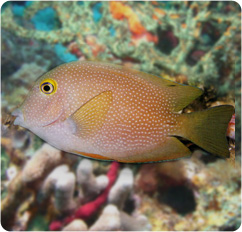|
Mark Martin on Achilles and Powder Blue Tangs

Thanks for the question. Both of these fish are extremely hard to keep unless you are very experienced with sensitive fish. The ones we sell at Blue Zoo Aquatics have been through a pretty extensive quarantine process before they are released for sale, meaning that when they reach you, they are eating well and disease free. Nonetheless, you still have to worry about these tangs breaking down with parasites and infection.
Sorry for the doom and gloom response, but the reality is that neither the Achilles nor the Powder Blue Tang would be my first choice for a reef tank, especially if it is only 90 gallons. If you want to give it a try, and think you can be successful based on your experience level, then by all means go ahead. As you probably know, Achilles Tangs are much rarer than Powder Blue Tangs; in fact, we have a waiting list for them as I type. The Achilles Tang is also by far the hardest one of the two to keep.
Now that you have been warned, let me tell you that the Achilles Tang, with its striking black body and red and white accents, is truly a beauty. If you do get one, know that these fish prefer turbulent water flow and a large open water column with unobstructed swimming space. They will frequently attack and harass other members of the acanthurid family–especially other Acanthurus tangs. The Achilles Tang is best kept as the only tang (and possibly only large) species in your tank.

The Powder Blue Tang, in my opinion, is one of the most beautiful fish available to the marine hobbyist. Like the Achilles Tang, the Powder Blue Tang may show signs of aggression toward all other Surgeonfish, and as such, it is best living as a single specimen. If the Powder Blue Tang is to be kept with multiple tangs, it is best to add them all at the same time.
As I mentioned above, 90 gallons, in my opinion, is a tad small for this genus let alone these species. If you get one that is no bigger than our medium size, you should be okay for quite a while, but you will need to provide this fish with a bigger tank eventually. The Achilles Tang is considered a nervous swimmer, as it frequently paces back and forth. Not providing a large enough space for this tang to move around in will likely see a very short life span.

If you are open to considering a different tang species, better long term choices would include anything in the Zebrasoma genus or the Ctenochaetus genus (such as the very cool Spotted Yellow Eye Tang - Ctenochaetus truncates - pictured here). These tangs have much smaller overall sizes and do extremely well in captivity. Plus both groups perform better janitorial work at removing algae.
Click here to see all of our tangs on the Blue Zoo website.
|